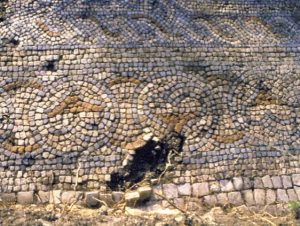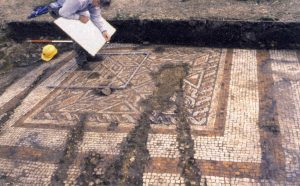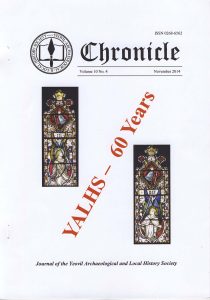This article came from the Chronicle published November 2014. Pages 121-123.
Roman Tesserae, Stone Tiles & Building Materials
Author: Hugh Prudden
The excavations at Lopen and Dinnington

The sites of two Roman villas, at Lopen and Dinnington, to the west of Yeovil were subject to archaeological investigation 12 to 13 years ago. The Lopen villa was discovered accidentally in the autumn of 2001, when part of a mosaic pavement was uncovered during construction of a new access road close to Bridge Farm. Subsequent rescue archaeology lead by Alan Graham revealed significant remains of a Roman villa. The archaeological deposits were very close to the surface and evidence of eight rooms was uncovered, including a fine mosaic pavement datable to c.360 AD. From the pottery found, it had been occupied from the 3rd until the early 5th century AD. Evidence for the presence of the Dinnington villa was indicated by crop markings in the dry summer of 1976. Trial trenching in 2000 uncovered a tessellated floor, immediately beneath the plough soil and this led to a visit by the Time Team in May 2002 (see Chronicle Vol 8 No. 4 p.94) but as they only had three days digging, the evidence found was limited. However, the presence of a hypocaust and another mosaic floor were indicative of the villa’s importance.
YALHS member and retired professional geologist, Hugh Prudden has had the opportunity to examine stone samples excavated from both villas, including individual tesserae from the mosaics and in this account summarizes the findings.
Under each description there are two sets of terms used to describe rocks:
- The nature of the rock e.g. colour, how the rock falls apart, sedimentary structures, non-clay minerals present, organic content, fossils.
- The name of the parent rock formation as shown on the geological map and indicating its geological age, such as the Devonian or Cretaceous periods, which are include in brackets.
The following is a summary of the various rock types associated with the Lopen and Dinnington sites.
Sandstones
- Brown/reddish well-cemented, non-calcareous, medium grain size, bedded sandstone. Gilbert Green (another ex-British Geological Survey expert) confirms that the rusty-brown sandstone may well have come from Mendip, possibly Beacon Hill, where the Roman Road passes old quarries. Old Red Sandstone (Devonian Period), found in mosaic at Dinnington.
- Clean, whitish, medium size-grain, calcareous quartz sand. Upper Greensand (Cretaceous) as at Warren Hill road cutting, west of Crewkerne. May have been used in mortar (?).
Limestones (Over 50% Calcium Carbonate, CaCO3)
- Golden, bioclastic (= shell fragments), sandy, ferruginous, cross-bedded limestone. Ham Hill Stone (Jurassic) from Ham Hill. Also found on many other Roman sites e.g. at Lufton and Ilchester.
- Golden sandy or pale yellow limestones. Inferior Oolite (Jurassic) e.g. as at Seavington St Mary quarry Site of Special Scientific Interest (ST 390 145). See Sheet 312 geological map for local outcrops. Found at Lopen site.
- Yellow-brown ferruginous, sandy, oolitic limestone. Inferior Oolite (Jurassic) e.g. as at Seavington St Mary SSSI quarry. See Sheet 312 geological map for local outcrops. Used in Lopen mosaic.
- White, mainly CaCO3, blocky, structureless limestone found on Dinnington site. Roger Bristow (ex British Geological Survey), who

Plate 131 Recording the mosaic at Dinnington, 2002. Photo. B&M Gittos knows the Dorset chalk very well, has suggested that a sample of Chalk tesserae from the Dinnington site might have been derived from the Lewes Nodular Chalk Formation. It has been used in Dorset and Wiltshire for building and walling. It would not have come from the Chalk outcrop on Warren Hill as this is muddier and softer.
- There were also much harder and more brittle samples of Chalk at the Dinnington site. These harder samples have probably suffered from severe compression due to earth movements and one piece also shows striations indicating differential movement, possibly associated with faulting. The lumps seemed rather big for tesserae. It is important to remember that Chalk was also used for liming fields. However that may be, Alan Graham reports (pers. comm.) that there were two styles of mosaic at Dinnington – the Corinium and Dorchester ‘schools’. The harder sample of Chalk may have come from the ‘Dorchester school’ mosaic. If this is so, it may have come from a Chalk outcrop on Purbeck. Dr M.E. Jones has reported on ‘White tesserae from Roman Dorchester’ (Proceedings of the Dorset Natural History and Archaeological Society, 110, 160-1), in which very similar hardened Chalk is described. He concludes that ‘The samples are definitely Chalk, most probably Middle or Upper Chalk (they contain no clay). This chalk is unusual in so far as it has undergone a rather complex diagenetic history which is similar to that of the Purbeck ridge …… The same Chalk at Stonehill Down, shows a major stylolite surface, and numerous fractures which are related to the intense deformation and to the passage of pore fluid through the rock. The tesserae samples almost certainly came from an outcrop of the material at Stonehill Down, or its equivalent.’
- Thin, well-bedded, laminar, fissile, fine grain-size, muddy, grey, clayey limestone/mudstone. A visit to the now worked-out Station Quarry at Charlton Mackrell has demonstrated that the lowest strata show beds that are identical to tesserae and stone tiles from Lopen. There is a perfect match with both. These beds belong to the Blue Lias Formation, the latter term referring to a collection of rocks of distinctive character that can be mapped. Much of the Blue Lias, as seen at Lyme Regis and the Somerset coast at Kilve, consists of alternating beds of limestones, mudstones and dark shales. However, the lowest beds are much thinner, and split into thin, even, laminated sheets. They are very fine grained. They represent pulses of limey mud deposited in non-turbulent seas. They tend to be grey, blue or off-white. The tops, bottoms and sides usually weather to a yellowish-brown colour owing to the effects of weathering. The colours are the result of the incorporation of sulphide bearing clays. The tile stones tend to be some 12mm thick whilst the tesserae are 20mm. There have been many quarries in the Blue Lias in the past that could have supplied these beds in the Langport – Somerton area.
- It is possible that thin beds from the White Lias were used for tesserae by the Romans. Can the tesserae from the Blue Lias and the White Lias be distinguished? The latter beds tend to have a whiter, more creamy outer surface whereas the Blue Lias beds tend to be off-white, grey or blue; many are blue-hearted. A fresh surface of a split piece of White Lias, observed with a hand lens, shows a marble-like recrystallised character and is pale fawn or creamy in colour. A fresh surface of Blue Lias may appear crystalline but is a ‘muddier’ fawn and/or grey colour; some have a more earthy texture. Other beds are distinctly blue-grey. It must be remembered that each bed in the White and Blue Lias has its own unique set of characteristics with regard to thickness, colour, texture, grain size, composition and fossil content. The Dinnington and Lopen samples appear to come from the Blue Lias.
The mortar
- The mortar contains smooth, well-rounded, very coarse white, translucent sand grains probably derived from the Upper Greensand. The mortar also contains a lot of angular, small flint chips, possibly ‘sweepings’ or sievings or broken with a hammer?
Hits: 3448
